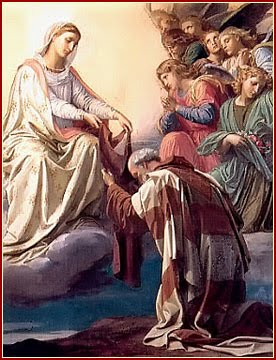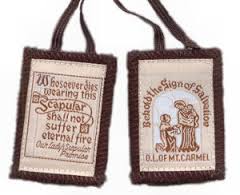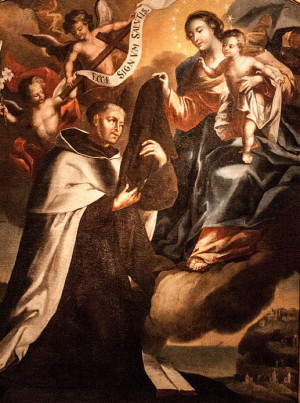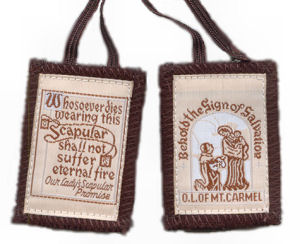
Summary of Our Lady of Mount Carmel. The cult of Mary under this title originated in the fourteenth century and came to be observed throughout the West during the eighteenth century. Commemorates the Virgin Mary as associated with Mount Carmel (Israel), site of the prophet Elijah’s altar to the one true God and of the twelfth century eremitical forerunners of the Carmelites. Mary is celebrated on this day as a model of reflection, solitude, and prayer.
Our Lady of Mount Carmel is a title given to Mary, the mother of Jesus, in honour of her having given the Scapular of Our Lady of Mount Carmel to Saint Simon Stock (see image). According to a pius tradition this took place at Cambridge in England in 1251. Patrick Duffy tells the story of the Carmelites.
 The Scapular
The Scapular
A scapular was originally a form of clothing, which monks wore when they were working. With the passage of time, it got a symbolic meaning: the cross to be borne every day as disciples and followers of Christ. In some religious orders, like the Carmelites, the scapular became a symbol of their way of life. It also became a badge of association with a particular religious group in a  lay third order. It signifies commitment to follow Jesus, like Mary, the perfect model of a disciple of Jesus.
lay third order. It signifies commitment to follow Jesus, like Mary, the perfect model of a disciple of Jesus.
Origins
The spiritual focus of the Carmelite Order is on contemplative prayer. Tradition traces the origins of the order to a small group of hermits – some of them crusaders – who gathered near the well of Elijah on the slopes of Mount Carmel in the Holy Land at the end of the 12th century. They saw themselves as succeeding the schools of the prophets in ancient Israel.
Mendicants
Early in the 13th century (1206-14), these hermits asked Albert, Patriarch of Jerusalem, for a rule of life in conformity with their proposed lifestyle. He responded with what is now called the Primitive Rule of Carmel. However, in 1238 this group was expelled from the Holy Land by the Saracens and they emigrated to Europe, where they took on a wider ministry (preaching, teaching, administering the sacraments). They were accepted as one of the new mendicant (literally, “begging”) orders, like the Franciscans and Dominicans. At first they settled in Cyprus and Sicily. By 1240 they were in Aylesford, Kent, England, and in 1245 they held their first general chapter at Aylesford where Simon Stock, then eighty years old was chosen as general.
ministry (preaching, teaching, administering the sacraments). They were accepted as one of the new mendicant (literally, “begging”) orders, like the Franciscans and Dominicans. At first they settled in Cyprus and Sicily. By 1240 they were in Aylesford, Kent, England, and in 1245 they held their first general chapter at Aylesford where Simon Stock, then eighty years old was chosen as general.
Spiritual Roots
Unlike other religious families, the Carmelites have no founder as such. When asked about their spiritual roots, Carmelites could not cite a Francis or a Dominic, but recall the prophet Elijah, whose exploits are narrated in 1 Kings 17-22. He appears like a thunderbolt at a time of drought, warning King Ahab that the reason a drought has come on Israel is that he and his people have deserted Yahweh and gone after the Baals (1 Kings 18:18). Elijah warns: “How long do you mean to hobble first on one leg then on another? If Yahweh is God, follow him; if Baal, follow him” (1 Kings 18:21). In a dramatic contest of sacrifice, the prophets of Baal are defeated. The people returned to Yahweh.
Zeal for the Lord
Carmelite spirituality remembers this radical contest. It is like falling in love and the pearl of great price. If your love is real, it will be all-consuming. All lesser loves fall away. Hence the motto of the Carmelite order is the quotation from 1 Kings 19:10,14: “With zeal I have been zealous for the Lord God of hosts.”
Reform: the Discalced Carmelites
A reform of the order took place in Spain, carried out by Teresa of Avila with the help of John of the Cross; this group separated and became the Discalced Carmelites. Teresa demanded the same single-mindedness. She compares the human heart to an “interior castle”, surrounded by “snakes and vipers and poisonous creatures”. These are the worldly attachments, the false gods, our inordinate desires. But only God really satisfies. Today there are two great Carmelite families – the Order of Carmelites (OCarm) and the Order of Discalced Carmelites (ODC).
 P.S. Another note on the Mount Carmel Scapular
P.S. Another note on the Mount Carmel Scapular
A pious tradition tells how Our Lady appeared to St. Simon Stock at Cambridge, England, in 1251. In answer to his appeal for help for his oppressed order, she appeared to him with a scapular in her hand (see image) and said: “Take, beloved son, this scapular of thine order as a badge of my confraternity and for thee and all Carmelites a special sign of grace; ‘Whoever dies in this scapular, will not suffer everlasting fire. It is the sign of salvation, a safeguard in dangers, a pledge of peace and of the covenant’. This promise is extended to all who out of devotion to the Mother of God wear her habit or badge; they are as if they were affiliated to the Carmelite Order.
Carmelites Today
At the end of the 19th century there were about 200 Carmelites in the world. By 2001, the membership had increased to approximately 2,100 men in 25 provinces, 700 enclosed nuns in 70 monasteries, and 13 affiliated Congregations and Institutes. In addition, the Lay Carmelites count 25-30,000 members throughout the world.
Among 20th century Carmelite figures are: St Thérèse of Lisieux, St Teresa of the Andes, Blessed Titus Brandsma, a Dutch scholar killed in Dachau because of his stance against Nazism, and St Teresa Benedicta of the Cross, (Edith Stein), a Jewish convert to Catholicism imprisoned and died at Auschwitz.